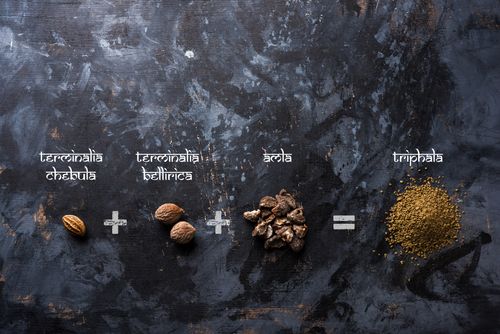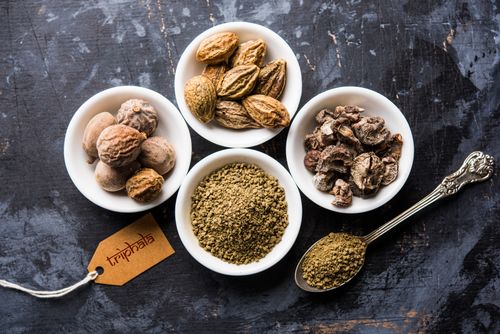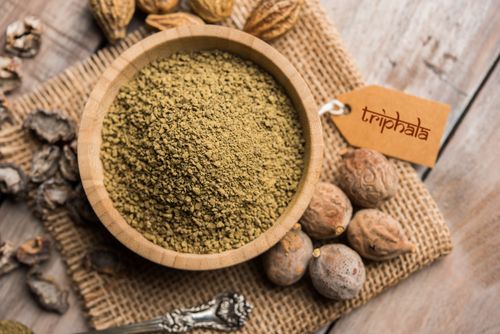Triphala and its Numerous Health Benefits HealthifyMe Blog HealthifyMe Blog - The definitive guide to weight loss, fitness and living a healthier life.
Triphala is a natural remedy, having its roots in Indian Ayurveda. Ayurveda is one of the world’s oldest medicinal systems dating back to over 3000 years. Ayurveda believes in enhancing overall well-being by reducing the root causes that create diseases in our bodies.
Triphala is the embodiment of this tradition. It eliminates root causes that lead to health issues. It is a mix of herbs that has immense health benefits. Such polyherbal mixes are celebrated in Ayurveda. The combined strength of these components mixed is much greater than their individual benefits.
Ayurveda believes the human body is made of three energies or doshas. Air, water, and fire are the three elements. The Triphala is called tridoshic rasayana in Ayurveda. This means that Triphala can balance and regulate all three energies of the body. In other words, it can boost general health and treat various ailments.
You can consume it in the form of tonics, powder, capsules, and juices. Many online sites sell Triphala in these variations. Herbal food stores are another place to look for them.
Triphala: The Reason Behind its Name
In Sanskrit, Tri means three and phala means fruits. Hence Triphala is nothing but the combination of three extremely potent fruits. These three fruits are amla (Emblica Officinalis), haritaki or harad (Terminalia Chebula), and bibhitaki or baheda (Terminalia belerica). You may know them as Indian gooseberry, black myrobalan, and belleric myrobalan.
These three fruits have numerous individual benefits. Drying and combining them in the correct ratio gives a powerful mixture with multiple health benefits. Triphala is commonly administered for metabolic, skin, and dental issues and healing wounds.
Amla
- Amla is one of the most celebrated fruits in Ayurveda. Traditionally, it is a home remedy to improve eyesight, cure fevers and regulate sugar levels.
- Amla is a small-sized green fruit. It has a distinctly sour taste with a crunchy texture inside. Pickles and fresh juices are some ways to add amla to your diet.
- It is a powerhouse of vitamin C and amino acids. Plant compounds like tannins, phenol, rutin, and emblicol are also present in this fruit.
- Studies show that amla helps to cure certain types of cancers. It is yet an area where research work is going on and the findings are yet to be concretised.
- Amla reduces bad cholesterol and keeps your heart healthy. It decreases kidney damage and supports its regular functioning.
- Flavonols present in amla are linked to enhancing memory power. Amla is also an excellent source of vitamin A, E and minerals like iron and calcium.
Bibhitaki
Bibhitaki is the ayurvedic name for belleric myrobalan. Southeast Asia is home to the fruits of this tree. They are widely used in various home remedies. It treats several problems due to bacterial and viral infections.
- It is a source of some powerful plant compounds like tannins, gallic acid, and ellagic acid.
- In Ayurveda, bibhitaki is praised for its power to treat diabetes. It regulates blood sugar levels.
- Plant compounds like ellagic acid and gallic acid promote the secretion of insulin in the body. By reducing high blood sugar, it is believed to cure diabetes.
- Bibhitaki acts as a detoxifier for the liver. It reduces lipid peroxidation and promotes liver health.
- It heals wounds with its tissue regeneration quality. The oil taken from the seed acts as a dressing for wounds.
- With regular use of bibhitaki there is increased awareness and concentration. It contains adaptogenic properties which help to boost brain health.
- It also contains anti-inflammatory properties.
Haritaki
Black myrobalan is used extensively in Ayurveda. It is called the ‘king of medicines’ and finds its origin in India, China, and middle eastern countries. Its ayurvedic name is haritaki and it is the third component of Triphala.
- The fruits of the Terminalia chembula tree are used to cure stomach problems, ulcers, and even asthma.
- Studies show that haritaki increases pain tolerance or threshold level and acts as a natural pain reliever. It also prevents cavities and other oral issues due to its anti-bacterial properties.
- Similar to the other components of Triphala, haritaki also contains strong plant compounds. Polyphenols, anthocyanins, and terpenes are some of them.
- Some of the key qualities of haritaki are its anti-inflammatory properties and its ability to cure digestive issues.
Nutritional Facts of Triphala
Triphala Powder is made up of Amla, Baheda & Harad in a 3:2:1 ratio, respectively.
Nutritional values of one teaspoon of Triphala are given below. (2.8 g)
- Calories: 10 g
- Carbohydrate: 3 g
- Fibre: 1 g
- Protein: 0 g
- Sugar: 0 g
Consuming a spoon of Triphala will have a small number of carbs and fibre. The sugar and fat content is negligible. Each of the three components of Triphala has its nutritional benefits.
10 Health Benefits of Triphala
1. Enhances oral health
Consuming Triphala is linked to improved oral hygiene and health. It can prevent various oral issues like gingivitis, plaque, and infections. It is an effective mouthwash to kill germs and bacteria. It also has the potential of reducing fungal growth and infections in the mouth.
2. Caters to skin issues
Vitamin C is abundant in Triphala. This helps to heal certain skin issues by protecting the skin cells. Vitamin C enhances collagen production, which can repair skin wounds. It also gives a youthful shine to the skin and nails.
3. Good for bowel movement
Triphala improves digestion. It contains some amount of fibre which can relieve constipation and bloating. It also promotes gut health by reducing the presence of harmful bacteria and increasing good gut bacteria.
4. Helps with swellings
All components of Triphala have plant compounds with high antioxidants. Many of them have anti-inflammatory properties. This helps in reducing arthritis induced discomfort. This can help to reduce swellings in joints which is what happens when one has arthritis.
5. Acts as a natural laxative
For many years, one of the most important uses of Triphala was that of a mere laxative. It promotes good bowel movement and provides relief from constipation. It reduces flatulence and detoxifies the body naturally.
6. Triphala Improves eye health
Amla is one of the three compounds of Triphala. Regular consumption of Triphala can strengthen eye muscles. It can reduce cataracts and other eye ailments as well.
7. Regulates sugar levels
Bibhitaka in Triphala regulates insulin production. This in turn manages blood sugar levels. With continuous use, it can cure certain types of diabetes.
8. Aids in weight loss
Triphala can accelerate weight loss. A study done in alternative therapies in Health and Medicine proves this. The mice which were the subject of the test showed an increase in good cholesterol and improved metabolism.
9. Contains stress relieving properties
Some studies show that Triphala can reduce stress and anxiety. It contains an adaptogen that helps to deal with stressful situations.
10. Boosts immunity
The vitamin C content in amla wards off infections and diseases. A study done in the Indian Journal of Pharmaceutical Sciences proves the immunity-boosting power of Triphala.
Common Ways of Consuming Triphala in India
Triphala comes in the form of powder, tablets, and tonics.
You can reap maximum benefit from Triphala when taken between meals, preferably on an empty stomach. Recommended dosage to start with is 500 mg to 1 g, to be consumed regularly for benefits. To treat severe constipation and other illnesses, increase the dosage with the help of professional guidance.
The tonic version of Triphala can be consumed as it is. To eat it as a paste, mix Triphala powder with pure cow’s ghee or raw organic honey. The powder can be mixed with warm water as well. It serves as a soothing drink to the body. Triphala in tea form is effective too.
Are There Risks with Consuming Triphala?
Triphala is purely made of herbal ingredients. Hence, it is fit for consumption for the majority of the people. Although no major side effects are linked with its use, taking certain precautions is advisable.
Triphala is a natural laxative that can treat constipation. Excess dosage can lead to diarrhea and stomach cramps in some people. It is advisable to consult with a doctor before increasing the dosage.
There are no studies to prove the risk or benefits of Triphala during pregnancy and breastfeeding. With inadequate information, it is best to check with a doctor before using it. Your immunity levels are compromised when you are carrying a baby. Always consult your doctor before administering something new during this phase.
Some studies show that Triphala can reduce the effect of blood thinners. Those who use high blood pressure and sugar medicines ought to be careful. Triphala is a natural remedy for the same. Hence combining it with other medication possesses the risk of lowering the blood pressure and sugar too low.
Conclusion
Triphala is a popular home remedy. Ayurveda considers this mixture as an antidote for multiple ailments. Each of them has its special healing properties, making Triphala a powerful mix.
All the components contain exceptional antioxidants, vitamins, and plant compounds. These help to fight diseases like diabetes, blood pressure and possibly some types of cancer. Triphala is beneficial to the overall wellness of the eyes, skin, and hair.
Include it in your diet in the form of pills, powder or even tea. Always go for the recommended dosage to avoid any risks. The bottom line is, consuming Triphala in any form regularly is good for the system. It can be a herbal alternative to regular immunity-boosters and vitamin tablets. Add it to your everyday routine to benefit overall health, provided you are not suffering from any major health issues.
Frequently Asked Questions (FAQs)
A. There have been certain studies that show that Triphala can boost metabolism. Triphala is said to act on the digestive tract and help in the faster elimination of toxins. Thus this improved strength of the colon tissue and gut health often reads to reduced adipose tissue, especially around the belly area.
A. Yes. It most certainly can! As mentioned above, it works on the gut and aids in the elimination of toxins. Other than this it also has a plethora of other benefits such as anti-inflammatory and antioxidant properties which are supposed to aid in fighting cancer, diabetes and boosting overall immunity.
A. Triphala primarily acts on the digestive system. It sometimes has a mild laxative effect which can cause the user to have diarrhea, abdominal cramps, and other abdominal discomforts. These symptoms can be seen sometimes even when consumed in small doses. So if you experience this, stop the intake immediately or consult a physician.
A. People on medication for chronic hypertension and diabetes should avoid taking Triphala as it reduces the efficacy of the allopathic medicines. Barring this, there are several other conditions in which it might be contraindicated, as its concentration may be severely increased or decreased by certain drugs. Antipsychotics, antiarrhythmic drugs, anti-fungal, and anti-convulsants should not be mixed with Triphala. As a rule of thumb, it’s best to consult your doctor before taking it so that they can tell you if your current drug regime will make Triphala a threat.
A. Yes. It is safe to consume 500gm to 1gm of Triphala daily for a normal healthy patient because, as mentioned above, it has several healing properties. It improves wound healing, helps alleviate constipation, is immunomodulatory, and even helps manage glucose levels. However, it is always wise to consult your physician before introducing something new into your daily diet.
The post Triphala and its Numerous Health Benefits appeared first on HealthifyMe Blog.
from HealthifyMe Blog https://ift.tt/3fayhKj



